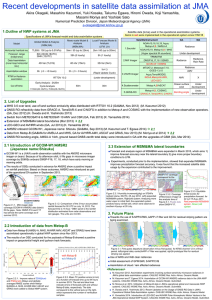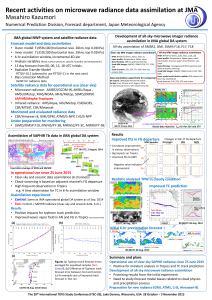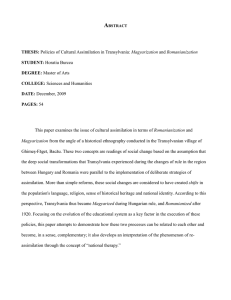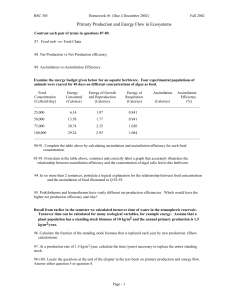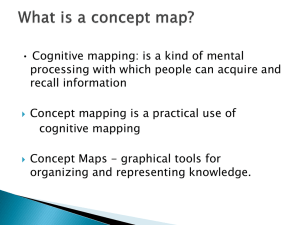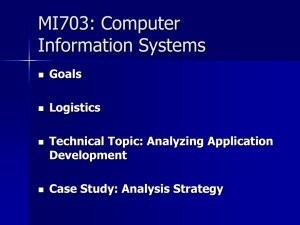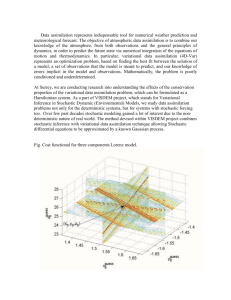Assimilation of AMSR2 at the Met Office Extending use of microwave imagers
advertisement
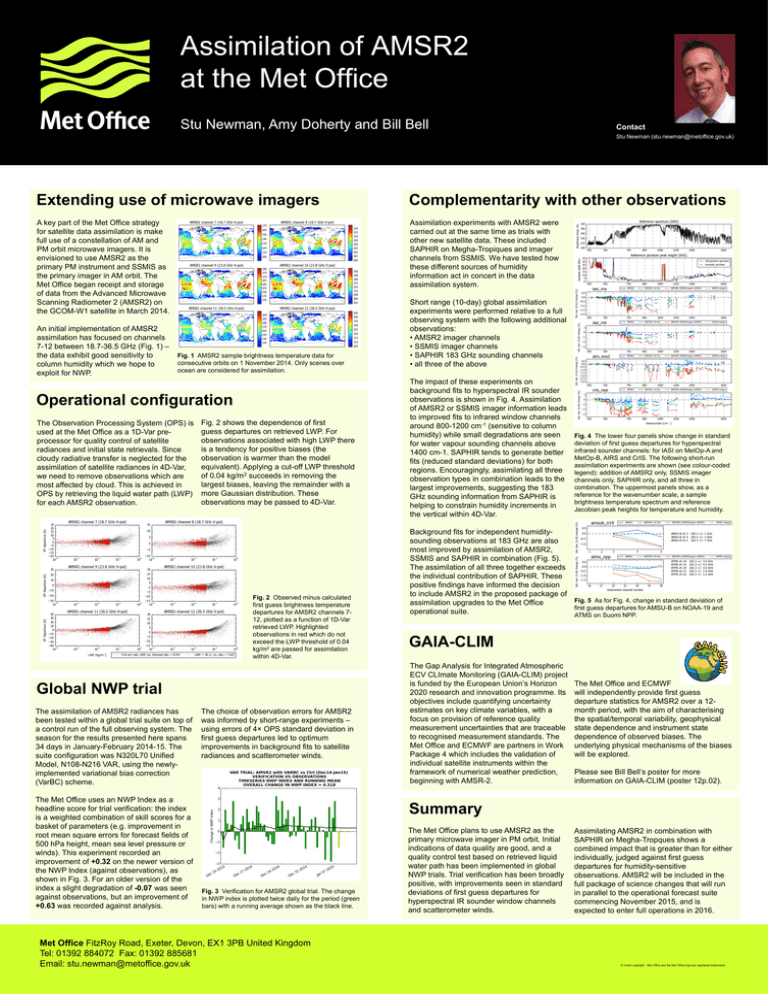
Assimilation of AMSR2 at the Met Office Stu Newman, Amy Doherty and Bill Bell Contact Stu Newman (stu.newman@metoffice.gov.uk) Extending use of microwave imagers Complementarity with other observations A key part of the Met Office strategy for satellite data assimilation is make full use of a constellation of AM and PM orbit microwave imagers. It is envisioned to use AMSR2 as the primary PM instrument and SSMIS as the primary imager in AM orbit. The Met Office began receipt and storage of data from the Advanced Microwave Scanning Radiometer 2 (AMSR2) on the GCOM-W1 satellite in March 2014. Assimilation experiments with AMSR2 were carried out at the same time as trials with other new satellite data. These included SAPHIR on Megha-Tropiques and imager channels from SSMIS. We have tested how these different sources of humidity information act in concert in the data assimilation system. An initial implementation of AMSR2 assimilation has focused on channels 7-12 between 18.7-36.5 GHz (Fig. 1) – the data exhibit good sensitivity to column humidity which we hope to exploit for NWP. Fig. 1 AMSR2 sample brightness temperature data for consecutive orbits on 1 November 2014. Only scenes over ocean are considered for assimilation. Operational configuration The Observation Processing System (OPS) is used at the Met Office as a 1D-Var preprocessor for quality control of satellite radiances and initial state retrievals. Since cloudy radiative transfer is neglected for the assimilation of satellite radiances in 4D-Var, we need to remove observations which are most affected by cloud. This is achieved in OPS by retrieving the liquid water path (LWP) for each AMSR2 observation. Fig. 2 shows the dependence of first guess departures on retrieved LWP. For observations associated with high LWP there is a tendency for positive biases (the observation is warmer than the model equivalent). Applying a cut-off LWP threshold of 0.04 kg/m2 succeeds in removing the largest biases, leaving the remainder with a more Gaussian distribution. These observations may be passed to 4D-Var. Fig. 2 Observed minus calculated first guess brightness temperature departures for AMSR2 channels 712, plotted as a function of 1D-Var retrieved LWP. Highlighted observations in red which do not exceed the LWP threshold of 0.04 kg/m2 are passed for assimilation within 4D-Var. Global NWP trial The assimilation of AMSR2 radiances has been tested within a global trial suite on top of a control run of the full observing system. The season for the results presented here spans 34 days in January-February 2014-15. The suite configuration was N320L70 Unified Model, N108-N216 VAR, using the newlyimplemented variational bias correction (VarBC) scheme. The Met Office uses an NWP Index as a headline score for trial verification: the index is a weighted combination of skill scores for a basket of parameters (e.g. improvement in root mean square errors for forecast fields of 500 hPa height, mean sea level pressure or winds). This experiment recorded an improvement of +0.32 on the newer version of the NWP Index (against observations), as shown in Fig. 3. For an older version of the index a slight degradation of -0.07 was seen against observations, but an improvement of +0.63 was recorded against analysis. The choice of observation errors for AMSR2 was informed by short-range experiments – using errors of 4× OPS standard deviation in first guess departures led to optimum improvements in background fits to satellite radiances and scatterometer winds. Short range (10-day) global assimilation experiments were performed relative to a full observing system with the following additional observations: • AMSR2 imager channels • SSMIS imager channels • SAPHIR 183 GHz sounding channels • all three of the above The impact of these experiments on background fits to hyperspectral IR sounder observations is shown in Fig. 4. Assimilation of AMSR2 or SSMIS imager information leads to improved fits to infrared window channels around 800-1200 cm-1 (sensitive to column humidity) while small degradations are seen for water vapour sounding channels above 1400 cm-1. SAPHIR tends to generate better fits (reduced standard deviations) for both regions. Encouragingly, assimilating all three observation types in combination leads to the largest improvements, suggesting the 183 GHz sounding information from SAPHIR is helping to constrain humidity increments in the vertical within 4D-Var. Fig. 4 The lower four panels show change in standard deviation of first guess departures for hyperspectral infrared sounder channels: for IASI on MetOp-A and MetOp-B, AIRS and CrIS. The following short-run assimilation experiments are shown (see colour-coded legend): addition of AMSR2 only, SSMIS imager channels only, SAPHIR only, and all three in combination. The uppermost panels show, as a reference for the wavenumber scale, a sample brightness temperature spectrum and reference Jacobian peak heights for temperature and humidity. Background fits for independent humiditysounding observations at 183 GHz are also most improved by assimilation of AMSR2, SSMIS and SAPHIR in combination (Fig. 5). The assimilation of all three together exceeds the individual contribution of SAPHIR. These positive findings have informed the decision to include AMSR2 in the proposed package of Fig. 5 As for Fig. 4, change in standard deviation of assimilation upgrades to the Met Office first guess departures for AMSU-B on NOAA-19 and operational suite. ATMS on Suomi NPP. GAIA-CLIM The Gap Analysis for Integrated Atmospheric ECV CLImate Monitoring (GAIA-CLIM) project is funded by the European Union’s Horizon 2020 research and innovation programme. Its objectives include quantifying uncertainty estimates on key climate variables, with a focus on provision of reference quality measurement uncertainties that are traceable to recognised measurement standards. The Met Office and ECMWF are partners in Work Package 4 which includes the validation of individual satellite instruments within the framework of numerical weather prediction, beginning with AMSR-2. The Met Office and ECMWF will independently provide first guess departure statistics for AMSR2 over a 12month period, with the aim of characterising the spatial/temporal variability, geophysical state dependence and instrument state dependence of observed biases. The underlying physical mechanisms of the biases will be explored. Please see Bill Bell’s poster for more information on GAIA-CLIM (poster 12p.02). Summary Fig. 3 Verification for AMSR2 global trial. The change in NWP index is plotted twice daily for the period (green bars) with a running average shown as the black line. Met Office FitzRoy Road, Exeter, Devon, EX1 3PB United Kingdom Tel: 01392 884072 Fax: 01392 885681 Email: stu.newman@metoffice.gov.uk The Met Office plans to use AMSR2 as the primary microwave imager in PM orbit. Initial indications of data quality are good, and a quality control test based on retrieved liquid water path has been implemented in global NWP trials. Trial verification has been broadly positive, with improvements seen in standard deviations of first guess departures for hyperspectral IR sounder window channels and scatterometer winds. Assimilating AMSR2 in combination with SAPHIR on Megha-Tropques shows a combined impact that is greater than for either individually, judged against first guess departures for humidity-sensitive observations. AMSR2 will be included in the full package of science changes that will run in parallel to the operational forecast suite commencing November 2015, and is expected to enter full operations in 2016. © Crown copyright Met Office and the Met Office logo are registered trademarks
